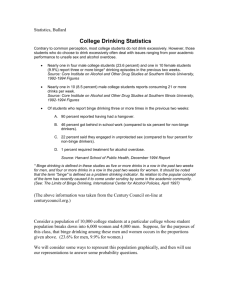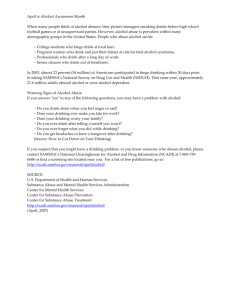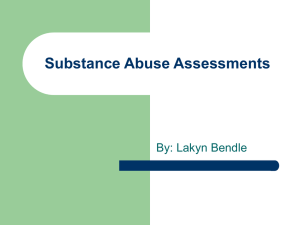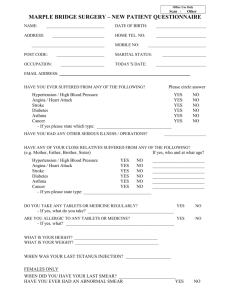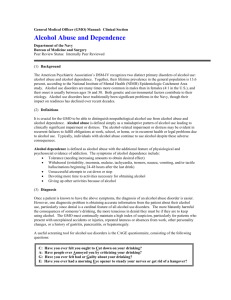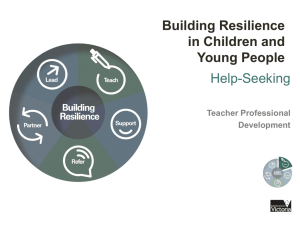ppt - Association for Criminal Justice Research
advertisement
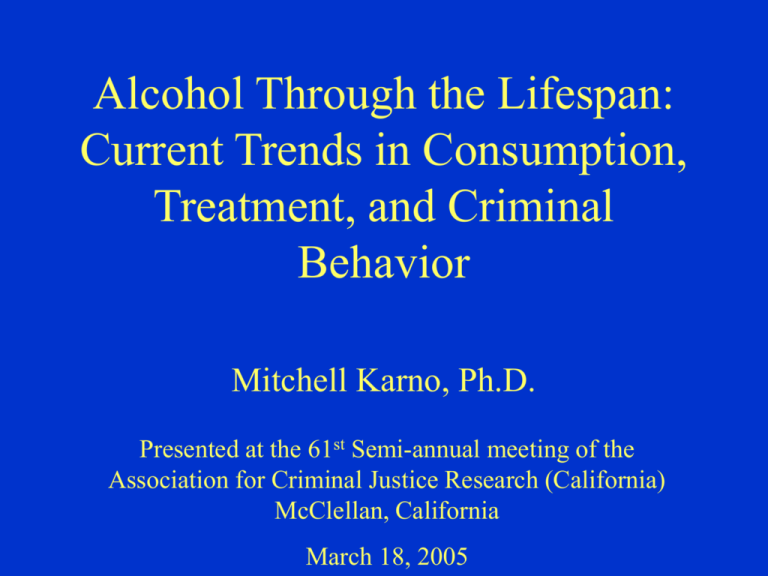
Alcohol Through the Lifespan: Current Trends in Consumption, Treatment, and Criminal Behavior Mitchell Karno, Ph.D. Presented at the 61st Semi-annual meeting of the Association for Criminal Justice Research (California) McClellan, California March 18, 2005 Costs of Alcohol Abuse to the Nation - 1990 Total: $98.6 Billion Core Medical Expenditures: Billion $10.5 Other Alcohol-related Costs: $15.8 Billion – – – – – – – Specialty organizations (33%) – Short-stay hospitals (44%) – Nursing homes (10%) – Support & Other (13%) Indirect: $70.3 Billion – Morbidity (52%) – Mortality (48%) Crime (36%) Victims of crime (3%) Incarceration (30%) Motor vehicle crashes (24%) Fire destruction (4%) Social welfare administration (1%) Fetal Alcohol Syndrome: $2.1 Billion Rice, 1993; NIAAA, Alcohol & Health, 1997 2.6 2.4 2.2 2.0 1.8 1.6 1.4 1.2 1.0 19 35 19 40 19 45 19 50 19 55 19 60 19 65 19 70 19 75 19 80 19 85 19 90 19 95 Gallons of ethanol Total per capita ethanol consumption, United States, 1997 2.8 Total Per Capita Consumption of Ethanol by State, United States, 1997 U.S. total = 2.18 DC 1.99 or below 2.00 to 2.24 2.25 to 2.49 2.50 or over Total Per Capita Consumption of Ethanol among Current Drinkers by State, United States, 1997 DC 3.99 or below 4.00 to 4.49 4.50 to 4.99 5.00 or over Concentration of U.S. Alcohol Consumption 100 90 80 60+ Percent of Total 70 50-59 60 50 40-49 40 30-39 30 20 18-29 10 0 2.5 5 10 20 Highest Volume 30 40 50 60 Percentile of Drinkers 70 80 90 100 Lowest Volume Greenfield TK & Rogers JD. J Stud Alcohol 60:78 (1999) Hazardous U.S. Alcohol Consumption Percent of Total 100 Wine 80 60 Spirits 40 20 Beer 0 2.5 5 10 20 30 40 50 60 70 80 90 100 Highest Volume Percentile of Drinkers Lowest Volume Rogers & Greenfield, 1999 Heavy Drinking by Age, Sex, and Race Nonblack Females Black Females Nonblack Males Black Males 20 18 16 14 Percent 12 10 8 6 4 2 0 18-29 30-44 45-64 Age 65+ Alcohol Consumption in U.S. 2002 & 2003 • About 65% of persons aged 12 or older reported any alcohol use in past year. • About 23% of persons aged 12 or older reported binge drinking in past 30 days. • About 7% of persons aged 12 or older reported heavy drinking in past 30 days. (SAMHSA, 2004) Heaviest Use Is Among Young Adults • Rates of binge and heavy drinking peak at age 21 (about 48% and 19%, respectively). • Young adults in college were somewhat more likely than their non-college counterparts to engage in binge or heavy drinking. (SAMHSA, 2004) With Age Comes Moderation? • Among young adults 18-25, rates of binge and heavy drinking are 42% and 15%. • Among persons 45-49, rates of binge and heavy drinking are 23% and 7%. • Among persons 65 and older, rates of binge and heavy drinking are 7% and 2%. (SAMHSA, 2004) How does California compare? 2001-2002 • 62% of Californians reported alcohol use in past year. • 45% of Californians aged 18-25 reported binge drinking at least once in past year. • 16% of Californians aged 18-25 reported at least weekly binge drinking over past year. (NIAAA, 2004) Definition of Alcohol Abuse • A person's maladaptive alcohol use causes clinically important distress or impairment, as shown in a single 12-month period by one or more of the following: – failure to carry out major obligations at work, home, or school because of repeated alcohol use, – repeated use of alcohol even when it is physically dangerous to do so, – repeated experience of legal problems, or – continued use of alcohol despite knowing that it has caused or worsened social or interpersonal problems. Definition of Alcohol Dependence • A person's maladaptive pattern of alcohol use leads to clinically important distress or impairment, as shown in a single 12-month period by three or more of the following: – tolerance; – withdrawal; – amount or duration of use often greater than intended; – repeatedly trying without success to control or reduce alcohol use; – spending much time using alcohol, recovering from its effects, or trying to obtain it; – reducing or abandoning important work, social, or leisure activities because of alcohol use; or – continuing to use alcohol, despite knowing that it has probably caused ongoing physical or psychological problems. Alcohol Abuse and Dependence by Age, Race, & Sex 25 Nonblack Females Black Females Nonblack Males Black Males Percent 20 15 10 5 0 18-29 30-44 45-64 Age 65+ NLAES, 1991 Alcohol Abuse & Dependence Aggregate-2001/2002 • Met criteria for diagnosis in past year: – Abuse: 4.3% – Dependence: 3.5% • Met criteria for diagnosis prior to past year: – Abuse: 16.2% – Dependence: 10.3% (NIAAA, 2004) Two Worlds of Alcoholism: Help-Seeking in 1991 • Only 10% of the U.S. adult population currently abusing or dependent on alcohol had received any treatment in the 12 months prior to interview. • Only 28% of individuals with a past diagnosis of alcohol dependence reported ever having any kind of alcohol treatment. • 75% of the people who recovered from a previous alcohol disorder did so without having received any treatment, often termed “natural recovery.” Help-Seeking 2001/2002 • Pattern of low help-seeking continues. • Among persons with recent alcohol abuse or dependence, only 7% reported seeking assistance in past year. • Only 25.5% of individuals with a past diagnosis of alcohol dependence reported ever seeking any kind of help. • 75% of persons with prior abuse or dependence no longer meet criteria. (NIAAA, 2004) Understanding Help-Seeking Pattern Demographics Clinical Issues Access Client Characteristics Demographics: GENDER Gender Disparities In Help-Seeking • Women may be less likely to enter alcoholism specialty treatment. • Women more likely to seek care in mental health or primary car/general medical settings. Source: Weisner et al., 1992; Grant, 1996; Kaskutas et al., 1997; Booth et al., 2000. NLAES=National Longitudinal Alcohol Epidemiologic Survey. Client Characteristics CLINICAL • • • • Alcohol use severity Psychiatric comorbidity Previous treatment Alcohol consequences • # symptoms DSM-IV alcohol use disorder (NLAES) • Diagnosis of alcohol disorder (NAS, NHIS) • Social consequences of drinking (NAS 1984 F/U, RAS) Source: Grant, 1997; Kaskutas et al, 1997; Booth et al., 2000, Hasin & Grant, 1995. NLAES=National Longitudinal Alcohol Epidemiologic Survey, RAS=Rural Alcohol Study, NAS=National Alcohol Survey, NHIS=National Health Interview Survey Client Characteristics ACCESS • Availability: • • • • availability in the geographic area -tremendous variation across U.S. Accessibility: travel time, driver's license, car -longer travel times reduce outpatient use Affordability: income, health plan, cost of care -NLAES: employment - HIP: better insurance coverage Acceptability: stigma Accommodation: convenience Source: Penchansky & Thomas, 1981; Fortney et al., 1995; Manning et al., 1996; Grant, 1997; Booth et al., 2000; Fortney & Booth, in press. RAS=Rural Alcohol Study; NLAES=National Longitudinal Alcohol Epidemiologic Survey; HIP=RAND Health Insurance Experiment Rural/Urban Differences in Access Variable Rural Income $30.5k Employment Health Insurance (any) Perceived Availability Tx 76% Travel Time (minutes) Residential Tx Center 39 Self-help Group 22 General Medical Provider Mental Health Center Acceptability Self-help Group 2.0 Mental Health Counselor Hospital Treatment Stigma Accommodation: Waiting Times Source: Booth et al., 2000. Urban $36.2k 85% 25 19 1.8 Independent Predictors of Help-Seeking Variable Demographics Race, Age Female Access Affordability Accessibility Availability Acceptability Social Support Clinical Recent Alcohol Dependence Social Consequences of Drinking Antisocial Personality Disorder Axis I DSM-III-R Disorder Drug Use Chronic Medical Problems Prior Alcohol Treatment * Booth et al., 2000. OR=odds ratio, listed only when p < 0.05. OR* 0.3 22 2.2 3.3 1.7 2.1 4.4 Locations & Providers of Care: Helping With Drinking The Rural Alcohol Study: 40 service users Percent 40% >= 1 Location 90 80 70 60 50 40 30 20 10 0 35% >= 1 Provider 90 55 25 52 22 17 Inp O E atie utpa R tien nt t Source: Booth et al., 2000. Sel f 32 7 Ge Psy Psy Oth n c c e -he era lp l M hiatri holog r st ist edi or cal S.W . Locations Providers The influence of alcohol on morbidity and mortality: AlcoholAttributable Fractions (AAF) AAF Age Causes of death directly attributable to alcohol 1.0 >15 Diseases indirectly attributable to alcohol Cancer of the esophagus Acute pancreatitis 0.75 0.42 > 35 > 35 Injuries and adverse effects indirectly attributable to alcohol Motor vehicle traffic and non-traffic deaths 0.42 Suicide and self-inflicted injury 0.28 Homicide and injury purposefully >0 > 15 inflicted by others 0.46 > 15 Source: Stinson, F.S., and DeBakey, S.F., Alcohol-related mortality in the United States, 1979-1988, Brit. J. Addict. 87:777-783, 1992. Alcohol & Criminal Behavior Drunk 51 or more days in past year In past year arrested for: YES (1,023) NO (23,482) Larceny or theft 1.8% 0.2% Burglary or breaking & 1.2 entering Drunkenness or liquor 4.0 law violation Aggravated assault 0.9 0.1 Other assault 0.3 3.3 (Health and Human Services NHSDA, 1997) 0.1 0.1 Alcohol & Workplace Violence • 1/3rd of victims of workplace violence between 1993 & 1999 believed the perpetrator was under the influence of alcohol or drugs at the time of the crime (Bureau of Justice Statistics, 2001). Alcohol & Domestic Violence • Perpetrator problem drinking has been associated with an 8-fold increase in intimate partner violence. (Walton-Moss et al., 2002) Alcohol & Youth Violence • Youth aged 12 to 17 who reported violent behaviors at school or at work reported high rates of past year alcohol use compared with youths who did not report violent behavior. (National Clearinghouse for Alcohol and Drug Information, 2002). • Alcohol has been implicated in 46 to 75 percent of the reported acquaintance rapes among 15-to-24year-olds. (National Center on Addiction & Substance Abuse, 1999). Summary • Alcohol consumption nationwide has remained relatively stable over the past several years. • Patterns of consumption in California are similar to that seen nationwide. • Binge and Heavy use peak among young adults, and then steadily decline with age. • Relatively few persons seek help for alcohol use problems. • Alcohol use is associated with increases in a wide variety of criminal activity.
